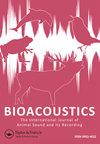树木密度和体型大小如何影响亚马逊护树蛙的声音信号?
IF 2.1
4区 生物学
Q2 ZOOLOGY
Bioacoustics-The International Journal of Animal Sound and Its Recording
Pub Date : 2023-04-27
DOI:10.1080/09524622.2023.2204313
引用次数: 0
摘要
摘要声学适应假说(AAH)预测,在植被密度较大的地点发出的声学信号应该具有增加信号传输的频谱和时间特征,但存在与体型有关的多效性:大型动物产生的信号频率较低。我们使用了来自两个植被密度不同的亚马逊雨林的34个亚马逊护士蛙种群的238个广告电话来测试树木密度是否影响声学参数的演变。我们使用PGLS来测试声学特征与表型、环境和地理预测因素之间的关系。叫声的光谱和时间特征与体型有异速关系。我们发现音符持续时间和身体大小之间存在一个新的二次关系。优势频率和体型之间的异速关系以及树木密度的直接影响表明,亚马逊护士蛙的进化轨迹与鸟类一样遵循一般的宏观进化模式。叫声的时间特征与AAH预测的进化轨迹相反;树密度较低环境中的青蛙比树密度较高环境中的蛙发出更长的音符,并且具有更高的音符率。亚马逊森林类型之间的细微差异可以在微观进化尺度上推动叫声的时间和光谱特征的声学多样化。本文章由计算机程序翻译,如有差异,请以英文原文为准。
How do tree density and body size influence acoustic signals in Amazonian nurse frogs?
ABSTRACT The Acoustic Adaptation Hypothesis (AAH) predicts that acoustic signals emitted at sites with greater vegetation density should have spectral and temporal characteristics that increase signal transmission, but there is a pleiotropism related to body size: large animals produce signals with lower frequency. We used 238 advertisement calls of 34 populations of Amazonian nurse frogs from two Amazonian rainforests with different vegetation density to test if tree density influences the evolution of acoustic parameters. We used PGLS to test for relationships between acoustic traits and phenotypic, environmental and geographic predictors. Spectral and temporal features of calls have an allometric relationship with body size. We found a novel quadratic relationship between note duration and body size. The allometric relationship between dominant frequency and body size and a direct effect of tree density indicates that the evolutionary trajectories of Amazonian nurse frogs follow a general macro-evolutionary pattern as in birds. The temporal features of calls have opposite evolutionary trajectories to those predicted by AAH; frogs from lower tree density environments emit longer notes and have higher note rates than those from denser-tree environments. Subtle differences between Amazonian forest types can drive acoustic diversification of temporal and spectral features of calls at micro-evolutionary scales.
求助全文
通过发布文献求助,成功后即可免费获取论文全文。
去求助
来源期刊
CiteScore
4.50
自引率
0.00%
发文量
25
审稿时长
>12 weeks
期刊介绍:
Bioacoustics primarily publishes high-quality original research papers and reviews on sound communication in birds, mammals, amphibians, reptiles, fish, insects and other invertebrates, including the following topics :
-Communication and related behaviour-
Sound production-
Hearing-
Ontogeny and learning-
Bioacoustics in taxonomy and systematics-
Impacts of noise-
Bioacoustics in environmental monitoring-
Identification techniques and applications-
Recording and analysis-
Equipment and techniques-
Ultrasound and infrasound-
Underwater sound-
Bioacoustical sound structures, patterns, variation and repertoires

 求助内容:
求助内容: 应助结果提醒方式:
应助结果提醒方式:


